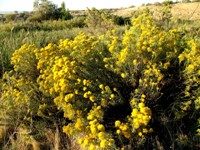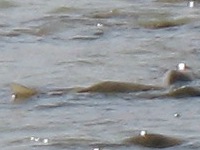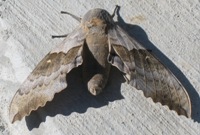Habitats
Highline Lake is surrounded by the high altitude desert that stretches from the Western Slope of the Rockies to the Eastern Slope of the Sierra Nevadas. The water in Highline Lake and Mack Mesa comes from the Colorado River. In Cameo, east of Palisade, Colorado River water is diverted into Highline Canal by a roller dam visible from I-70. Highline is fed from the canal on the east side by a spillway. Due to the high sediment load present in Colorado River water, the East Inlet becomes very shallow without regular dredging.
The East Boat Ramp is closed currently for this very reason. Ecologically this is not a bad thing as it has created a wetlands area home to amphibians and carp making it a favorite stop for migratory shore birds. Below the dam, fed by a spillway, there are several man-made pools to facilitate a wetlands-type environment. Excess water not going into the pools flows into Mack Wash and back to the Colorado River.
Naturally, Mack Wash would have been dry most of the year except during storms leading to flash floods. The water level at Mack Mesa is controlled manually. The lake is very shallow, which is one reason why motorized boats are not allowed. It has a comparatively low volume to Highline and pollutants would be much more concentrated on the fish that live there.
Plants
 Park uplands are dominated by mat saltbush shrub lands and saline bottomland shrub lands. Mat saltbush shrub land is dominated by several low growing or prostrate saltbush species, including mat and Gardner saltbush, shadscale and horsebrush. These shrubs tolerate high concentrations of sodium and sulfate contained in shale-derived soils. Saline bottomland shrub lands are dominated by greasewood, rabbitbrush, four-wing saltbush, shadscale, salt-cedar, western wheatgrass, Indian rice grass and needle-and-thread grass. Prickly pear cacti are abundant and sumac (non-poisonous) has also been known to grow in the area. The picnicking areas
Park uplands are dominated by mat saltbush shrub lands and saline bottomland shrub lands. Mat saltbush shrub land is dominated by several low growing or prostrate saltbush species, including mat and Gardner saltbush, shadscale and horsebrush. These shrubs tolerate high concentrations of sodium and sulfate contained in shale-derived soils. Saline bottomland shrub lands are dominated by greasewood, rabbitbrush, four-wing saltbush, shadscale, salt-cedar, western wheatgrass, Indian rice grass and needle-and-thread grass. Prickly pear cacti are abundant and sumac (non-poisonous) has also been known to grow in the area. The picnicking areas
 and campground are well treed, mostly by cottonwoods and pines. A variety of willows and fruiting trees can also be found (apricot, chokecherry, crabapple, plum). There are also poplars, elms, and tamarisk in the area.
and campground are well treed, mostly by cottonwoods and pines. A variety of willows and fruiting trees can also be found (apricot, chokecherry, crabapple, plum). There are also poplars, elms, and tamarisk in the area.
Wildlife
Mammals
 Most of the mammals in the park are nocturnal and only come out at night. During the day you can see squirrels, rabbits, prairie dogs, and mule deer. The mule deer have been known to visit the campground at dusk. At night skunks, foxes, raccoons, coyotes, and beavers come out to play. Fox dens can be noted on the trails by a strong odor of urine. Raccoon tracks can be found in muddy areas, especially the east inlet and the beaches around Mack Mesa. The best place to catch a daytime mule deer sighting is the wetlands below the dam.
Most of the mammals in the park are nocturnal and only come out at night. During the day you can see squirrels, rabbits, prairie dogs, and mule deer. The mule deer have been known to visit the campground at dusk. At night skunks, foxes, raccoons, coyotes, and beavers come out to play. Fox dens can be noted on the trails by a strong odor of urine. Raccoon tracks can be found in muddy areas, especially the east inlet and the beaches around Mack Mesa. The best place to catch a daytime mule deer sighting is the wetlands below the dam.
Reptiles
 Lizards of several varieties can be seen all day along the trails that surround the park. Skinks, fleets, collared lizards, horny toads, corn snakes, and bull snakes are a common sight at the picnic cabanas on the west side and at Mack Mesa. Garter snakes can be seen slithering through the grass underneath shrubs in the campground. No poisonous species have been recently reported at Highline. The only poisonous species natural to the area is the pygmy rattler and it is usually found in higher altitudes.
Lizards of several varieties can be seen all day along the trails that surround the park. Skinks, fleets, collared lizards, horny toads, corn snakes, and bull snakes are a common sight at the picnic cabanas on the west side and at Mack Mesa. Garter snakes can be seen slithering through the grass underneath shrubs in the campground. No poisonous species have been recently reported at Highline. The only poisonous species natural to the area is the pygmy rattler and it is usually found in higher altitudes.
Amphibians
 Mudpuppies, leopard frogs, and toads are the native amphibians to the park. Mudpuppies are large salamanders. Bullfrogs are also common but non-native. If you would like to use bullfrogs for food or bait, feel free to harvest as many as you like as Colorado considers them invasive. If you decide to take bullfrogs you may not keep them alive and leave the park with them.
Mudpuppies, leopard frogs, and toads are the native amphibians to the park. Mudpuppies are large salamanders. Bullfrogs are also common but non-native. If you would like to use bullfrogs for food or bait, feel free to harvest as many as you like as Colorado considers them invasive. If you decide to take bullfrogs you may not keep them alive and leave the park with them.
Fish
 Many different species of fish, both native and non-native are present in Highline Lake and Mack Mesa. We have channel catfish, carp, trout, crappie, sunfish, bluegill, large-mouth and small-mouth bass.
Many different species of fish, both native and non-native are present in Highline Lake and Mack Mesa. We have channel catfish, carp, trout, crappie, sunfish, bluegill, large-mouth and small-mouth bass.
The outlet by the dam features a fish net to prevent the out-migration of stocked fish back to the Colorado River. This is part of the initiative to protect the endangered fish species in the Colorado River from sport fish that may compete for resources.
Arthropods
 In the water crawdads are a common find. The desert areas of the park are home to many fascinating insects and arachnids. Sun spiders can be found in abundance in the arid desert areas around Highline. They are very strange looking creatures with a four-part jaw and strange limbs (pedipalps) that extend in front of them reminiscent of a scorpion’s pincers. Sun spiders are beneficial like many arachnids because they eat nuisance insects, other spiders (including poisonous species like black widows), and scorpions.
In the water crawdads are a common find. The desert areas of the park are home to many fascinating insects and arachnids. Sun spiders can be found in abundance in the arid desert areas around Highline. They are very strange looking creatures with a four-part jaw and strange limbs (pedipalps) that extend in front of them reminiscent of a scorpion’s pincers. Sun spiders are beneficial like many arachnids because they eat nuisance insects, other spiders (including poisonous species like black widows), and scorpions.
 They are not poisonous or dangerous to people despite their fairly creepy appearance. Giant desert hairy scorpions can be found hiding under rocks in dry areas as well. Tarantulas are also common in the desert, but all of these large ground dwelling arachnids are nocturnal. The desert hairy scorpion sting is often described as similar to a bee sting. Orb weavers, funnel web spiders, and daddy-long-legs can also be found hiding around the park.
They are not poisonous or dangerous to people despite their fairly creepy appearance. Giant desert hairy scorpions can be found hiding under rocks in dry areas as well. Tarantulas are also common in the desert, but all of these large ground dwelling arachnids are nocturnal. The desert hairy scorpion sting is often described as similar to a bee sting. Orb weavers, funnel web spiders, and daddy-long-legs can also be found hiding around the park.
 Beautiful dragonflies buzz around the wetland areas of the park. Several species are in attendance at any one time. Don’t confuse them with the also pretty damselflies! Damselflies can fold their wings back upon landing where dragonflies always have their wings out. During the hottest weeks of the summer you might even hear a few cicadas in the pinions!
Beautiful dragonflies buzz around the wetland areas of the park. Several species are in attendance at any one time. Don’t confuse them with the also pretty damselflies! Damselflies can fold their wings back upon landing where dragonflies always have their wings out. During the hottest weeks of the summer you might even hear a few cicadas in the pinions!

